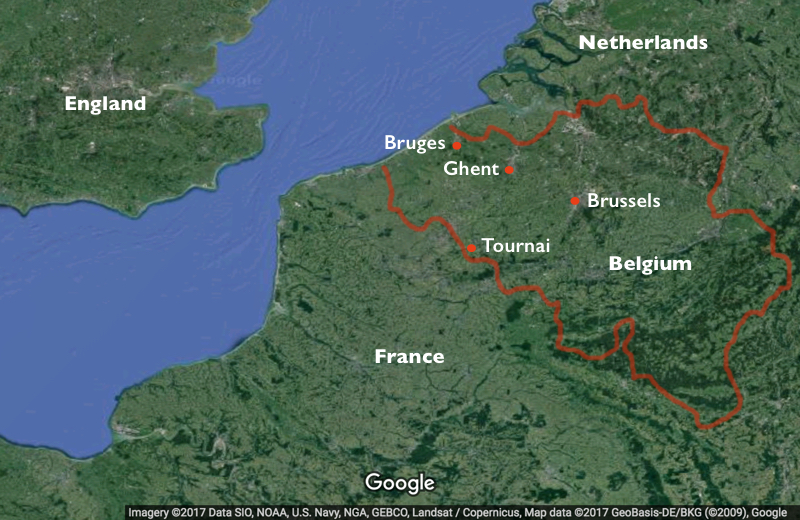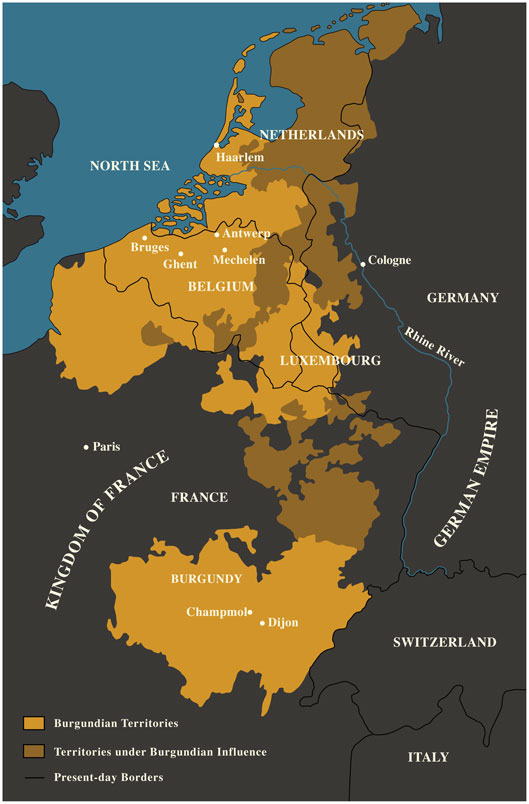Introduction to 15th Century Flanders
Flemish art

“Flemish art” is a difficult term: medieval Flanders does not have the same borders as it does today. It is used by art historians loosely to refer to artistic production in Flemish speaking towns—particularly Bruges, Ghent, Brussels and Tournai. The term is also most often associated with painting. Painters like Jan van Eyck, Rogier van der Weyden, and Hugo van der Goes were as internationally famous in their time as they are now, finding patrons not only in the Low Countries (today Netherlands, Belgium and northern Germany), but in Italy also, where their oil-paint technique had a considerable influence.
Part of the Burgundian court

In 1384 the count of Flanders, Louis II, died, and he was succeeded by his son-in-law, Philip the Bold, the fourth son of King John II of France and the Duke of Burgundy. Flanders was from then ruled by a series of Burgundian dukes, and many craftsmen from the Flemish towns were enlisted by the Burgundian court where they would work for the duke and his courtiers.
After the death of Duke Charles the Bold in 1477, the Burgundian lands were partitioned between France and the Holy Roman Empire, and many Netherlandish artists lost the court’s patronage as a result.[1]
Classical antiquity?
In Italy, the Renaissance was deeply influenced by the art and culture of Ancient Greece and Rome—in part because the art and architecture of antiquity was more immediately available (ruins were plentiful in many cities). Northern Europe however did not have such ready access to ancient monuments and so tended to draw instead more directly from medieval traditions such as manuscript illuminations.
Oil paint: glazes
Though the medium of oil paint had been in use since the late Middle Ages, the artists of the North more fully exploited this medium’s unique characteristics. Using thin layers of paint, called glazes, northern artists created a depth of color that was entirely new, and because oil paint can imitate textures far better than fresco or tempera, it was perfectly suited to representing the material reality that was so important to Renaissance artists and their patrons. In the Northern Renaissance, we see artists making the most of oil paint—creating the illusion of light reflecting on metal surfaces or jewels, and textures that appear like real fur, hair, wool or wood.
The great artists of this period created work that reflected their increasingly mercantile world, even when they worked for the court of the Dukes. The spiritual world reigned supreme but the representation of wealth and power were also a hugely important motive for patrons whether a pope, a duke, or a banker.[2]
- Dr. Andrew Murray, "Introduction to Fifteenth-century Flanders," in Smarthistory, August 23, 2017, accessed February 15, 2023, https://smarthistory.org/flanders/ ↵
- Dr. Steven Zucker and Dr. Beth Harris, "Northern Renaissance art under Burgundian rule," in Smarthistory, August 9, 2015, accessed February 16, 2023, https://smarthistory.org/burgundy-and-the-burgundian-netherlands/ ↵

